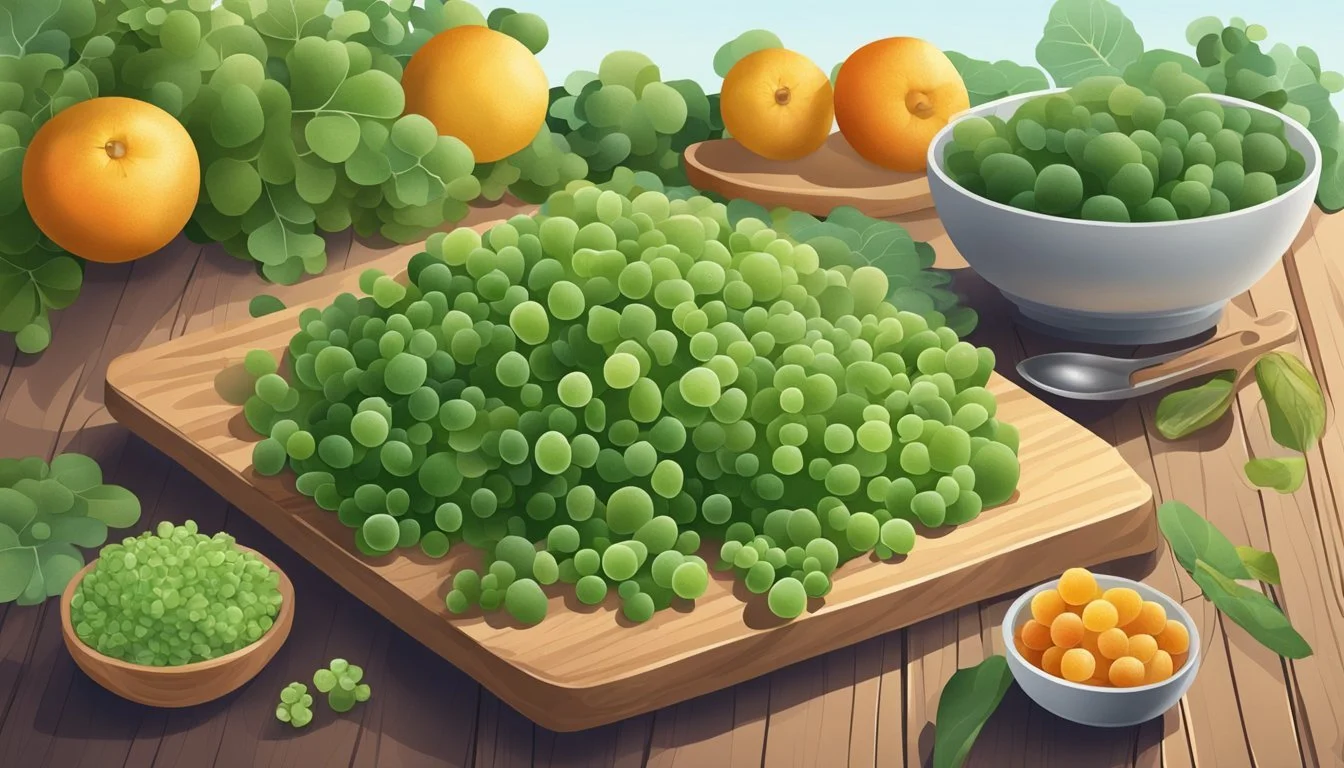Sea Grapes Substitutes
Top Alternatives for Your Recipes
Finding substitutes for sea grapes can be a challenge, but there are several edible seaweeds and other alternatives that can mimic their unique texture and flavor. Sea grapes, known scientifically as Coccoloba uvifera, have a fresh ocean taste and a distinct popping texture when eaten, similar to caviar. For those unable to find sea grapes, or looking for a vegan caviar alternative, edible seaweeds such as wakame and hijiki provide a similar texture and burst of flavor.
Another option for replacing sea grapes is vegan caviar made from seaweed. This plant-based alternative offers the same delicate popping experience as sea grapes and traditional caviar, without any animal products. It’s becoming increasingly popular due to its similarity in taste and texture, as well as its sustainability and ethical benefits.
For those looking to replicate the unique qualities of sea grapes, these substitutes offer varied yet satisfying alternatives, each with its own subtle nuances. Whether using wakame's softness, hijiki's earthiness, or the innovative vegan caviar, these substitutes ensure a delightful culinary experience.
Understanding Sea Grapes
Sea grapes are a type of seaweed known for their unique texture, nutritional benefits, and specific culinary uses. They are commonly found in East Asian regions and are valued both for their flavor and health benefits.
Origins and Distribution
Sea grapes, known as umibudo in Japanese, are primarily found in Okinawa, Japan, and other parts of East Asia including the Philippines and Indonesia. They thrive in warm, shallow waters and are a staple in many coastal communities.
They are harvested sustainably to ensure they remain plentiful and can regenerate naturally. Due to their adaptability, they are also cultivated in different parts of Southeast Asia.
Culinary Profile
Sea grapes are praised for their mild, salty flavor that resembles the taste of the ocean. When eaten, they provide a refreshing pop that many people compare to kombu and wakame. The texture is often described as slightly crunchy and juicy, making them a popular addition to various dishes.
They can be consumed raw, often added to salads or as a garnish to enhance the umami flavor of a dish. Their natural salinity means they pair well with other seafoods and sushi.
Nutritional Information
Rich in essential vitamins and minerals, sea grapes are a nutritional powerhouse. They are an excellent source of vitamins A, C, and E, promoting healthy vision, skin, and immune function. They also provide iron and calcium, which are crucial for maintaining strong bones and blood health.
Sea grapes contain a significant amount of fiber, aiding in digestion and promoting a healthy gut. The presence of iodine supports thyroid function, while other minerals and nutrients contribute to overall well-being.
Comparing Sea Grapes with Other Seaweeds
When comparing sea grapes with other seaweeds like wakame, nori, and kombu, several differences and similarities stand out. Sea grapes offer a crunchier texture compared to the soft texture of wakame or the dried, crispy quality of nori. While kombu shares the salty flavor, sea grapes are more mild and less overpowering.
Nutritionally, sea grapes are comparable to these seaweeds, each providing its set of beneficial nutrients. Sea grapes are particularly known for their richness in antioxidants and essential minerals, making them a valuable addition to any diet.
Selecting and Preparing Sea Grapes
Sea grapes, known for their distinct texture and bursts of flavor, are a versatile ingredient in many dishes. Ensuring you buy fresh sea grapes and use effective preparation methods will enhance their quality and taste in any recipe.
Purchasing Tips
When buying sea grapes, it's essential to source them from reputable online retailers or specialty markets. Freshness can be assessed by their vibrant green color and plump appearance. Avoid sea grapes that appear wilted or have a strong fishy odor, indicating they may be past their prime.
Key indicators of quality include:
Color: Should be a fresh green.
Texture: Plump and firm.
Smell: A mild, oceany scent.
Consider buying from retailers who offer overnight shipping to ensure maximum freshness. Additionally, look for certifications or reviews that attest to the quality of their sea grape offerings.
Preparation Methods
Proper preparation begins with rinsing sea grapes thoroughly under cold water. This removes any residual salt and dirt. Soak them briefly if they're too salty, but avoid hot water, as it can ruin their texture.
For salads or sushi, keeping them raw preserves their unique texture. Pair with a simple soy and vinegar dipping sauce, or incorporate them as a garnish. In Okinawan cuisine, they are often combined with miso for a healthy side dish. Always add sea grapes just before serving to maintain their crispness.
Popular preparation ideas:
Salads: Add them raw for a crunchy texture.
Sushi: Use as a fresh topping.
Dipping Sauces: Pair with soy and vinegar.
Garnishes: Elevate rice bowls or sashimi presentations.
Substitutes for Sea Grapes
When sea grapes are not available, various alternatives can be used to mimic their texture, taste, and nutritional benefits. These include other seaweeds, plant-based substitutes, and caviar-like alternatives.
Alternative Seaweeds
Wakame and Kombu are two seaweeds that can serve as substitutes for sea grapes.
Wakame is often used in salads and soups and has a slightly sweet flavor. Its texture is similar to sea grapes, making it a good alternative in various dishes.
Kombu is another seaweed that can be utilized due to its firm texture and umami flavor. It is commonly used in broths and stews, giving dishes a depth of flavor that can replicate the taste of sea grapes.
Plant-Based Substitutes
Lettuce and Blueberries are viable plant-based options to replace sea grapes in salads or garnishes.
Lettuce, especially varieties like Butterhead or Romaine, can add a crisp texture similar to sea grapes. It doesn't have the exact taste but can replicate the mouthfeel in salads and wraps.
Blueberries provide a burst of sweetness and a similar size to sea grapes. They are great for adding a nutritional punch and a touch of color to dishes. Their versatility allows them to be used in a wide range of recipes from smoothies to baked goods.
Caviar Alternatives
For a caviar-like experience, vegan caviar and seaweed caviar are excellent substitutes.
Vegan caviar, often made from ingredients like agar-agar or kelp, mimics the texture and appearance of fish roe. It provides a similar briny flavor, making it a suitable alternative for sea grapes in gourmet dishes.
Seaweed caviar, particularly those made from algae like Chlorella or Spirulina, offer a nutritious and sustainable option. These products have small, bead-like structures that can easily substitute for sea grapes in sushi, salads, and as garnishes for seafood dishes.
Incorporating Sea Grapes into Your Diet
Incorporating sea grapes into your diet introduces a variety of vitamins and minerals, in addition to unique textures and flavors. They can be integrated into both traditional dishes and modern culinary creations.
Sea Grapes in Traditional Dishes
In Okinawa, sea grapes are often used in salads and served as an appetizer or a side dish. They provide a crisp texture and slightly salty flavor that complements fresh ingredients. It's common to find sea grapes as a topping for sashimi, adding not only a fresh crunch but also a nutritional boost, including vitamins and minerals that are essential for health.
Sea grapes can be added to rice bowls, where they enhance the dish with a burst of oceanic taste and visual appeal. This ingredient is also used in various traditional soups and stews, contributing to the complexity and depth of flavors. Their presence in these dishes makes them a staple in regions where they are harvested.
Sea Grapes as a Modern Ingredient
Sea grapes have gained popularity as a modern ingredient in various fusion cuisines. Used in sushi rolls, they lend an interesting texture and subtle brininess, making each bite unique. Restaurants often pair sea grapes with other seafood elements to boost the dish's health benefits, thanks to their rich nutrient content.
They can also turn a simple salad into a sophisticated and exotic dish, either by themselves or alongside other fresh vegetables and proteins. Chefs are exploring their potential in appetizers, where sea grapes act as a garnish or an integral component, highlighting their versatility.
Their application is not limited to traditional Asian dishes. Sea grapes have found their way into Western cuisine as well, making appearances in gourmet plates such as seafood platters and contemporary rice bowls.
Health Benefits and Considerations
Sea grapes, known for their rich nutritional profile, offer a variety of health benefits. Their contributions to cardiovascular health, skin enhancement, and dietary considerations make them a versatile addition to any diet.
Enhancing Heart Health
Sea grapes are loaded with unsaturated fatty acids and omega-3 fatty acids, which are crucial for heart health. These compounds help lower blood cholesterol levels, reducing the risk of heart disease.
Antioxidants present in sea grapes further support cardiovascular health by preventing oxidative stress, which is a key factor in the development of atherosclerosis. Moreover, the high fiber content aids in maintaining healthy lipid profiles, making sea grapes a beneficial addition to a heart-healthy diet.
Skin and Beauty Advantages
Sea grapes are rich in compounds beneficial for skin health, including hyaluronic acid and antioxidants. Hyaluronic acid is known for its moisture-retaining properties, which keep the skin hydrated and plump.
Antioxidants such as vitamins A, C, and E help combat free radicals that cause skin aging, thus preserving skin elasticity and reducing the appearance of fine lines. Regular consumption or topical application of sea grapes can lead to enhanced skin texture and a more youthful appearance.
Dietary Considerations
Sea grapes are a low-calorie food, making them an excellent choice for weight management. They are rich in dietary fiber, which supports digestive health by promoting regular bowel movements and preventing constipation.
The high vitamin and mineral content, including calcium, magnesium, and iodine, contributes to overall well-being. Sea grapes' high protein content also makes them a valuable food source for those looking to increase their protein intake without adding extra calories.





